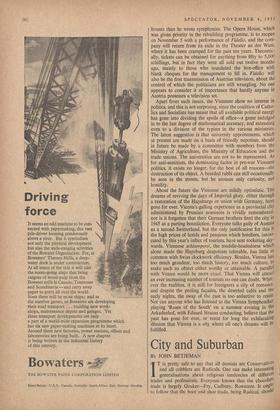City and Suburban
By JOHN BETJEMAN IT, is pretty safe to say that all dentists are Conservatives and all cobblers are Radicals. One can make interesting generalisations about religious tendencies of different 'trades and professions. Everyone knows that the chocolate trade is largely Quaker—Fry, Cadbury, Rowntree. It ought to follow that the boot and shoe trade, being Radical, should also be Nonconformist. But, of course, asking the people is a delicate matter, especially on the telephone. Freeman, Hardy and Willis in Leicester refused to speak to me except through their operator, who said they were too busy to take telephone calls. Even if I had got through, I should have been nervous of asking them whether they were Congregational. Baptist or Methodist. Lilley and Skinner were very friendly, but I could not find out at once their religious beliefs. The Clarks of Somerset are Quakers. Northampton, the centre of the boot trade, has a statue of Charles Bradlaugh, a 'devout atheist' to use Stanley Morison's phrase. Arelixologists tend to be atheists or agnostics. Scientists, on the other hand, are by no means all non-Christians. Within the Church, writers, journalists, wine- merchants and actors are inclined to be 'high,' with a tendency in the first and last categories to go over to Rome. Doctors and retired Service people are generally 'low% so are nurses. This is all very dangerous ground and likely to offend sus- ceptibilities; but why are certain occupations connected with certain religions? Why are the dress and fur trades mostly Jewish? Why are so many of the big speculative builders Plymouth Brethren? It's all a theme about which some bore can write a thesis. I prefer to leave it as a paragraph in slightly bad taste, because it is not good form to mix up everyday life with religion.
CASUALTY LIST
The annual report of the excellent National Buildings Record is once again a melancholy record of destruction. There are beautiful photographs of Bowood and Roundway Park, both in Wiltshire; Kirkleatham Hall, Yorkshire, with its splendid saloon by Chambers and Kerr; Wiganthorpe Hall and Chevet Hall, in the same county; Aberglasney. Car- marthenshire; Watnall Hall, Nottinghamshire; and Egginton Hall, Derbyshire. the home of Lord Waterpark. (I believe it Was Sir Osbert Sitwell who heard somebody say : 'Derby- shire's never been the same since the Waterparks left.') All are beautiful Georgian buildings destroyed or doomed, irre- placeable reminders of our greatest age of house-building. Since the report, the following destructions have been planned : Owsden Hall, Newmarket, late eighteenth century, is almost down. Boulge Hall, Suffolk, of various dates and connected with Edward Fitzgerald, has been bought by a demolisher. Rushbrooke Hall, Suffolk, a moated Tudor building with beautiful Georgian plaster-work, and belonging to Lord Rothschild, has been so long full of unchecked dry-rot that It is to be demolished. Apley Castle. Salop, and Conington, Huntingdonshire, both eighteenth-century Gothic. arc to be destroyed, and—almost the most romantic of all—Belhus, Essex. At the present rate of destruction, there will in twenty- seven years be no big Georgian country houses left in England and Wales.
GOOD HOME OFFERED
What has happened to the Buxton Memorial Fountain, that many-coloured wonder which stood on the corner of Great George Street and Parliament Square from 1869 until five years ago? It was designed by S. S. Teulon, a highly original architect, and though it may not be everybody's taste today, it had guts and grace, and was a welcome relief from the dull, official look of much recent State statuary. It commemorated the abolition of slavery. If whoever has got it doesn't want it, I wonder if 1 could use these columns to ask for it to be given to me. I 'we in Mintage, the birthplace of King Alfred, and there is a spring on my lawn known as Alfred's Bath which would suit it adthirably. But, still more, I would like to see it erected to, give colour to one of our drabber London open spaces— Clapham Common or Queen's Park, for instance.











































 Previous page
Previous page